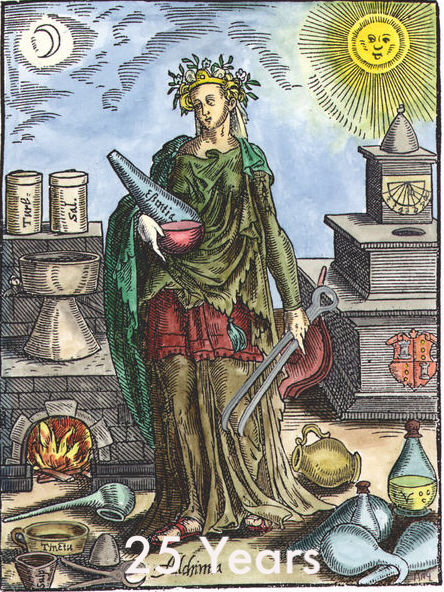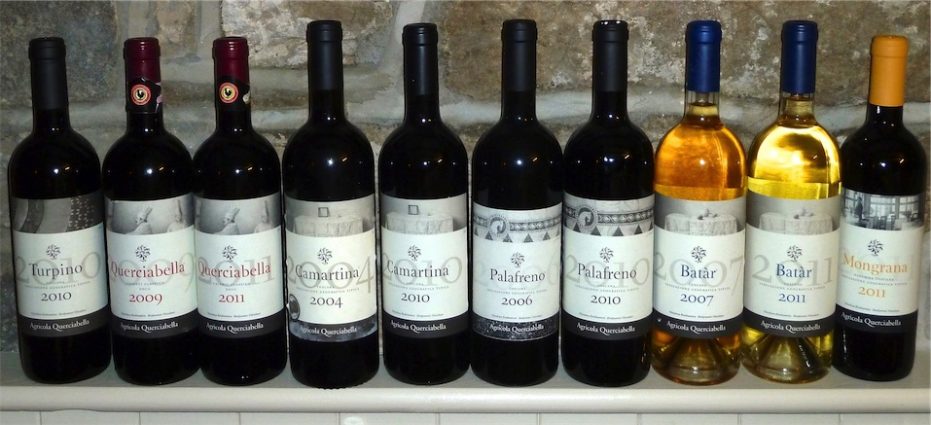The wines of Querciabella, redux
My admiration of Querciabella increases with each new vintage. I have shown their wines at many events; they are my benchmark of Tuscan excellence. Time then, for an overview. Querciabella redux is a summary of my many and various scribbles about Querciabella during the past few years.
In the centre of the prosperous Tuscan hills, between Siena and Florence, sits the headquarters of Querciabella, at Greve-in-Chianti. There are vines planted at every turn on these beautiful rolling hills, for this is the Chianti Classico heartland.
Giuseppe Castiglioni founded Querciabella in 1974. Initially, it consisted of a few rundown farm buildings and just one hectare of vines. Castiglioni was a wealthy industrialist, wine collector and reputedly the owner of the largest collection of Cristal Champagne in Italy. What he created at Querciabella became the stuff of legend. It is now one of Italy’s greatest wine estates, making authentic wines of uncompromised quality and authenticity.
Biodynamic brilliance
Giuseppe’s son, Sebastiano Cossia Castiglioni, has developed it far beyond its humble beginnings. He is a polymath, conservationist, and a committed Vegan. Querciabella went organic in 1988 and transitioned to biodynamics in 2000. There are no animal products used at Querciabella, so the wines are suitable for vegetarians and vegans. As an aside, because biodynamic methods usually require cow-horns, a ceramic alternative was developed. Meanwhile, a recent conservation initiative was Bee Biodynamic, dedicated to saving honeybees.
Querciabella is now the largest biodynamic wine estate in Italy, with 100 hectares under vine. There is 74 ha of vines and a modern winery at Greve. Those vineyards produce four wines: Chianti Classico, the white Bátar, and the red Palafreno and Camartina Super-Tuscan’s. In the Noughties, Querciabella expanded into new territory by planting 36 ha of Sangiovese, Cabernet and Merlot at Albarese. Some 50 miles distant on the Maremma coast, these were biodynamic from the outset, making two IGP’s; Mongrana and, in part, Turpino.
Below are my impressions of each of the six Querciabella wines, tracked over many years. I’ve listed them in the order they first became introduced.
Chianti Classico DOCG, 13.5%
The style has changed and improved over the years. Once, this was a blend of 90% Sangiovese with 10% Cabernet Sauvignon, sometimes with a splash of Syrah and Merlot. Now it’s 100% pure Sangiovese. The wines are matured in small French oak casks for 12 months before blending. New oak is no longer a feature. The aromas are abundant and complex; strawberry, dried cherry and figs, oak showing as a whiff of vanilla, then an herbal tea quality. The palate is dry with fresh acidity. The tannins are tight when released and ideally, need a year or two to mellow. This juicy mouthful has some oak spices, and remarkably delicate vanilla notes peep through a balsamic finish.
A 10-15 year lifespan is usual, depending on the vintage. There’s an average of 90,000 bottles made every year, with a Riserva made in the best years with 5% new oak that is a keeper. In short, this is one of the best Chianti Classico’s that you can buy with a delicacy few peers can match.
Hic! Wine Merchants £19.00
Camartina, IGP Toscana, 14%
Querciabella’s flagship red wine, first made in 1981, this Super-Tuscan is magnificent. Made from 70% Cabernet Sauvignon and 30% Sangiovese, again sometimes with a splash or Merlot and Syrah. It is only produced in the best vintages and gets two years in French oak, 80% of which is new and the rest just one-year-old.
This wine is stunning. A blackish colour and what a nose! Coffee and tobacco/cedar dominate and a great invitation to a very sophisticated palate. Powerful red fruits and damsons hit first; then blackcurrant. When young it’s a little austere, the tannins are still in abundance, but the texture is silken from the outset. Despite the amount of oak employed, the wine can take it and so the effects are subtle – a toasty and coffee undercurrent that integrates over time as the wine settles down for a very long life. Finally, there’s that classic Italian finish, very slightly bitter, very more-ish.
As this opens up in the glass over an hour and more, new insights reveal themselves as the tannins relax their grip. Keep for ten years and bring out for a special occasion with a two-hour decant first. It’s seduction in a glass, with tremendous energy and excitement. Around 12,000 bottles per year on average.
Lay & Wheeler £62.50
Bátar, IGP Toscana, 13.5%
Bátar is remarkable. If ever there was a dry white wine with Testicoli, this is it. Since the first vintage in 1988, it’s been favourably compared with the best white Burgundy. Its original name was Bâtard, being an homage to Bâtard-Montrachet, but the French didn’t like that! 50% Chardonnay and 50% Pinot Bianco are fermented and matured in French oak barriques, 50% of which are new. The sheer intensity of this wine is almost overpowering. There should be no elegance or finesse possible with such a hulk, yet there is grace in abundance.
Truly a wine of contradictions, this is never to be drunk young as it improves markedly over five-ten years or more. Bold, brassy and leggy, the opulent nose is butterscotch and vanilla via toasty oak, initially masking a more delicate white blossom scent. The new oak treatment dominates the palate, with vanilla and a delicious creamy texture in the mouth. The finesse comes from intense citrus and peach fruit and steely acidity. It leaves a final impression of bonfire smoke and cinder toffee. In recent years the oak treatment has been turned down a notch or two, but it still needs time for the oak to integrate and knit together. An average of 15,000 bottles made per year. One of Italy’s greatest white wines; this is biodynamite.
Hic! Wine Merchants £48.00
Palafreno, IGP Toscana, 14%
The first release was in 2000, and that was a blend of Merlot and Sangiovese. Now Palafreno is always 100% Merlot, and so it’s Querciabella’s sole monovarietal wine. The are only around 3,000 bottles each year. It was christened Palafreno after Ariosto’s epic poem of 1516 called Orlando Furioso. (This naming convention then continued with the wines below).
This wine has a lovely silky texture, all red berry and blackcurrant with great freshness and elegance that rolls into a long milk chocolate and toast finish. Although there’s a relatively low level of tannins, it is a little astringent when young and needs a couple of years to soften and plump up, revealing nuances of menthol. A thoroughbred, though in a more international style, this is a lovely wine capable of giving great pleasure over many years.
Single bottles from recent vintages seemed to have disappeared from UK wine lists, perhaps because of its small production. However, Corney and Barrow have it for about £85 each, but the minimum is a case of six.
Mongrana, Maremma Toscana IGP 13%.
Newbies might want to start here! Mongrana is now the entry-level young vine wine in the Querciabella range at a wallet-friendly price. It tastes great too! The first vintage was in 2005. With 130,000 bottles per year, each release features a different picture on the label.
Mongrana is 50% Sangiovese with equal parts of Cabernet Sauvignon and Merlot. Just a small part matures in oak barriques for three months. Expensive new barriques would only mask the vibrant ripe fruit. Hence this is a wine designed for young, immediate drinking though it does improve over a couple of years. There are typically Italian aromas; sour red cherries accompanied by dried herbs and spices. The palate shows plenty of juicy fresh acidity. Initially, cherry flavours are to the fore then cassis, damson, cloves and cinnamon appear. Hints of earth and almonds finish it off.
Medium bodied, with an elegant balance of acid, alcohol and fruit. Drink it young while it’s fresh and exuberant. Terrific value.
Hic! Wine Merchants £12.50
Turpino, Toscana IGP. 14%
Turpino is 40% Cabernet Franc with 40% Syrah and 20% Merlot. The first vintage was in 2007. Blending grape varieties isn’t unusual. What is unusual is that this mixes Tuscan regions. Fruit from Greve brings elegance, combined in equal proportion with fruit from the warmer and plusher sea-level Maremma. While this is heretical to the terroir-purist in me, adopting this approach has created an exciting red wine.
With only 20% of the wine maturing in old barrels, the wine hasn’t any wood flavours. Because Cabernet Franc is tannic, it uses tighter grained barrels that don’t add wood tannin into the wine. Blending is after sixteen months, then another eight months integration in cement tanks before bottling. 20,000 bottles per year on average.
This red wine has red cherry and damson fruit scents, plus pencil shavings from the Cabernet Franc. On the palate, the fruit is seamless yet multilayered. There’s an exotic balsamic touch that lingers on the finish. A wine of elegance rather than muscular power. The melange of fruit flavours balances fresh acidity and soft polished tannins. Fresh-thinking Tuscan style at its finest.
Hic! Wine Merchants £22.50.
Conclusions
The purity that Querciabella achieve is striking; so force yourself to linger over each glass. The wines are all distinctly different. My personal favourite remains the Chianti Classico, especially in Riserva years. It’s tempting to opt for three bottles of the Chianti Classico instead of one Camartina. However, this choice can’t ever be easy; much depends on your mood and your bank manager.
Via di Barbiano, 17
50022 Greve in Chianti (FI)
Maremma Estate
Località Banditella, 65
58010 Alberese (GR)
For Sebastiano and Carlo, inspirations both.
A comparison of some of these wines with those of the biodynamic Caiarossa estate is a fascinating exercise!

